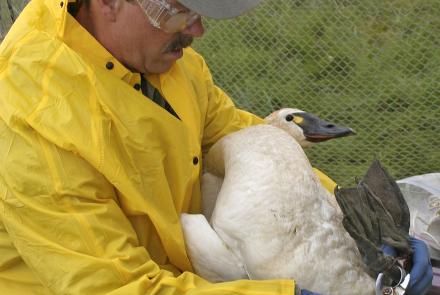The Rare Red Aurora
On the nights of March 12 and 13 this year, many Alaskans saw an extraordinary gift from the sun: a stunning display of the northern lights with great patches of red aurora.
Three days earlier on the sun, enormous flares had erupted. Thursday's flare, extending 70,000 miles into space, was one of the largest ever recorded. Eight minutes later, light from the flare reached observers on earth.
That radiation traveled at the speed of light, but the particles causing auroras move more slowly (about 400 kilometers a second, or 900,000 miles an hour). Instruments at the College Observatory on the University of Alaska Fairbanks campus recorded effects caused by arriving particles at 4:30 p.m. Sunday.
Auroras are produced by subatomic particles--electrons and protons--cast off by the sun. The particles stream outward into space as an enhanced flow called the solar wind. When the solar wind and the earth's magnetic field interact, electrical power is produced. The resulting electrical discharge in the upper atmosphere creates auroras in the same way a discharge works in a neon sign. The gases give off photons, or light, and we see the aurora. Our location relative to the magnetic field makes Alaska, especially the Interior, one of the world's best places for observing aurora.
In a typical auroral display, the light is a mixture of many colors. There's actually a fair bit of blue, but the human eye doesn't pick it up very well. We see much better in the green part of the spectrum, and there is a strong yellowish-green component in the light of a usual aurora, so we often see green displays. Green auroras, and green auroras with a reddish lower border, occur at an altitude near 100 kilometers (60 miles) above the earth.
Rare, all-red auroras occur much higher, at 300 to 500 kilometers altitude and are associated with a large influx of electrons. These electrons are moving too slowly to penetrate deeply into the atmosphere: they actually have less energy than the electrons that create more common auroras.
At this high altitude, the electrons lose their energy only to the most abundant constituent, oxygen atoms. The process produces light as pure as that from a laser; there's no mixture of colors to confound the eye. Instead, light is produced at exactly 6300 and 6364 angstrom units on the spectrum, and we see true red aurora.
Auroral scientists do not yet fully understand the cause of pure red aurora. They know it is associated with intense solar activity and heating of the upper atmosphere from a large influx of low-energy electrons; they have not yet explained the mechanism producing this occurrence.
The most impressive red aurora visible in North America during the last half-century occurred on February 11, 1958. And it really was visible in North America, seen in California and even Florida. In Alaska, the show lasted nearly all night. The red light in the sky was so intense it made the snow on the ground gleam red.
Solar storms and flares occur in cycles and solar physicists have predicted the sun will be producing more and bigger flares during the current cycle. Because it will peak next year, we may yet see a red aurora to match the one of 1958.




